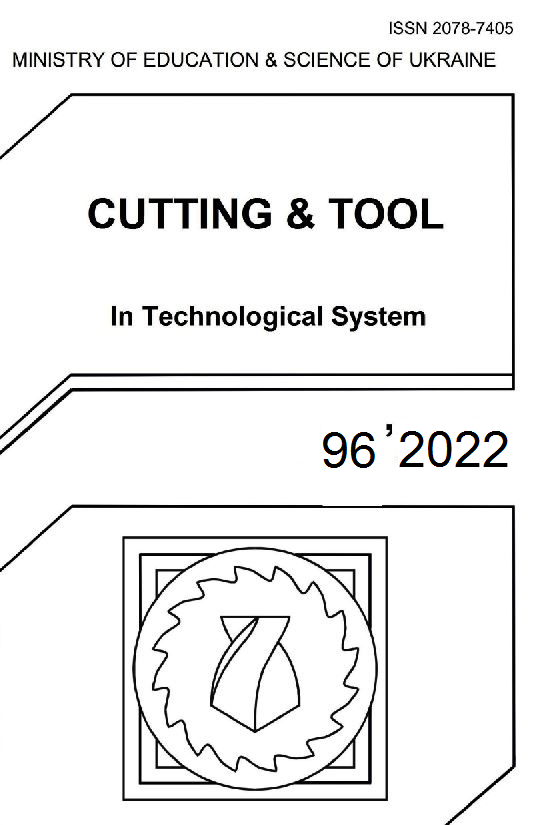WEAR RESISTANCE OF HARD TURNED SURFACES
DOI:
https://doi.org/10.20998/2078-7405.2022.96.07Keywords:
hard turning, wear resistance, 3D surface roughnessAbstract
The quality of working surfaces plays an important role in automotive industrial components. One of the main characteristics of such surfaces is their wear resistance. In this study external cylindrical surfaces were analyzed. A Design of Experiment methodology was applied and hard turning experiments were carried out to analyze the effects of the cutting parameters on the 3D surface roughness values of reduced peak height, skewness and kurtosis. The study confirmed earlier findings that at lower feed the wear resistance is higher based on the analyzed roughness parameters. The cutting speed and the depth-of-cut do not influence these parameter values significantly.
References
Linins, O., Krizbergs, J., Boiko, I.: Surface texture metrology gives a better understanding of the surface in its functional state, Key. Eng. Mater., No.527, 2013, pp.167–172, DOI: 10.1016/j.precisioneng.2016.06.001.
Karpuschewski, B., Kundrak, J., Emmer, T., Borysenko, D.: A new strategy in face milling-inverse cutting technology, Solid State Phen., No. 261, 2017, pp.331–338.
Grzesik, W., Rech, J., Zak, K.: High-precision finishing hard steel surfaces using cutting, abrasive and burnishing operations, Procedia Manuf., No.1, 2015, pp. 619–627, DOI: 10.1016/j.promfg.2015.09.048.
Zawada-Tomkiewicz, A.: Analysis of surface roughness parameters achieved by hard turning with the use of PCBN tools, Estonian J. Eng., No.17, 2011, DOI: 10.3176/eng.2011.1.09.
Kundrak, J., Nagy, A., Markopoulos, A.P., Karkalos, N.E.: Investigation of surface roughness on face milled parts with round insert in planes parallel to the feed at various cutting speeds, Cut. Tools Technol. Syst., 2019, pp.87–96, DOI: 10.20998/2078-7405.2019.91.09.
Mamalis, A.G., Kundrak, J. Horvath M: On a novel tool life relation for precision cutting tools, J. Manuf. Sci. Eng., No.127, 2005, pp.328–332, DOI: 10.1115/1.1794158.
Grzesik, W., Zak, K., Kiszka, P.: Comparison of surface textures generated in hard turning and grinding operations, Procedia CIRP, No.13, 2014, pp.84–89, DOI: 10.1016/j.procir.2014.04.015.
Blawucki, S., Zaleski, K.: The effect of the aluminium alloy surface roughness on the restitution coefficient, Adv. Sci. Technol. Res. J, No.9, 2015, pp.66–71, DOI: 10.12913/22998624/59086.
Gogolin, A., Wasilewski, M., Ligus, G.; Wojciechowski, S.; Gapinski, B.; Krolczyk, J.; Zajac, D.; Krolczyk, G.: Influence of geometry and surface morphology of the U-tube on the fluid flow in the range of various velocities, Measurement, No.164, 2020, art. no.108094, DOI: 10.1016/j.measurement.2020.108094.
10. Varga, G., Ferencsik, V.: Analysis of surface topography of diamond burnished aluminium alloy components, Lecture notes in mechanical engineering, 2017, pp.143–154.
Molnar, V.: Tribology and Topography of Hard Machined Surfaces, Rezanie i instrumenty v tekhnologicheskih sistemah, No. 94, 2021, pp.49–59.
Gadelmawlaa, E.S., Kourab, M.M., Maksoucf, T.M.A., Elewaa, I.M., Solimand, H.H.: Roughness parameters, J. of Mat. Proc. Techn., Vol. 123, 2002, pp.133–145.
ISO 25178-2:2012 Geometrical product specifications (GPS) - Surface texture: Areal - Part 2: Terms, definitions and surface texture parameters. 2012.
Stout, K., Blunt, L.: Three-dimensional Surface, Topography. 2 ed. London: Penton Press, 2000. 15. Bitelli, G., Simone, A., Girardi, F., Lantieri, C.: Laser Scanning on Road Pavements: A New Approach for Characterizing Surface Texture, Sensors, No.12, 2012, pp.9110-9128, DOI: 10.3390/s120709110.
Downloads
Published
Issue
Section
License
Copyright Notice
Authors who publish with this Collection agree to the following terms:
1. Authors retain copyright and grant the Collection right of first publication with the work simultaneously licensed under a Creative Commons Attribution License that allows others to share the work with an acknowledgement of the work's authorship and initial publication in this Collection.
2. Authors are able to enter into separate, additional contractual arrangements for the non-exclusive distribution of the Collection's published version of the work (e.g., post it to an institutional repository or publish it in a book), with an acknowledgement of its initial publication in this Collection.
3. Authors are permitted and encouraged to post their work online (e.g., in institutional repositories or on their website) prior to and during the submission process, as it can lead to productive exchanges, as well as earlier and greater citation of published work.

